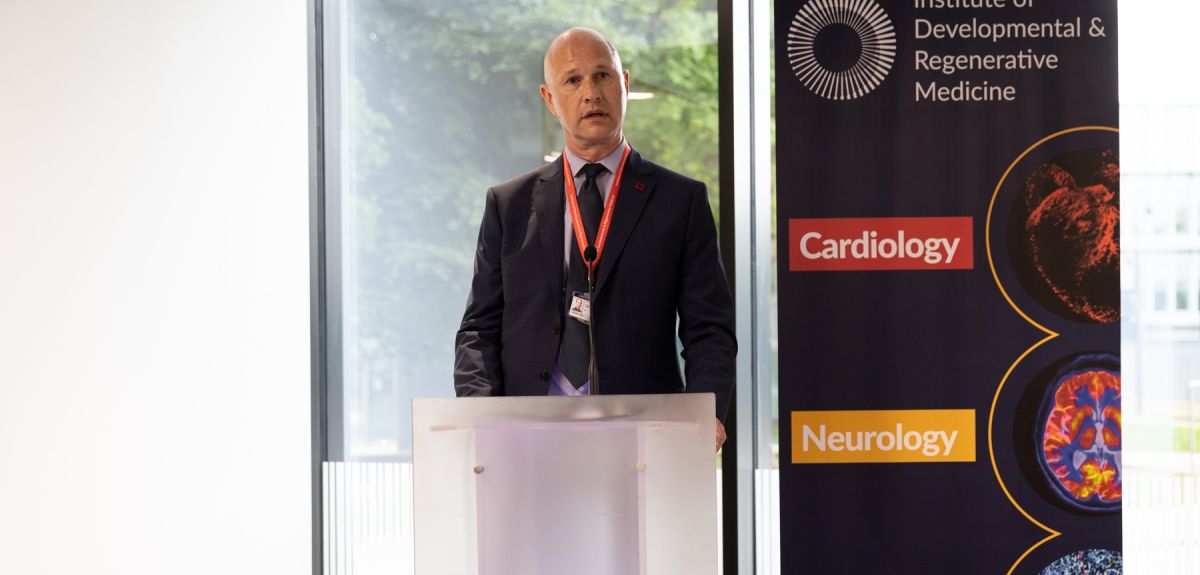
Image credit: Cyrus Mower Photography
Bringing scientists back together
Professor Paul Riley, Director of the Institute of Developmental and Regenerative Medicine discusses how better-designed research buildings can help scientists break out of their silos.
The advances made in medical and biological sciences within our lifetime are staggering. It seems strange to think that the project to sequence the human genome took over a decade to complete back in 2001, yet similar sequencing technology is now portable and is used daily in the field.
Each advance in research has opened up new avenues of exploration and with each new stride whole new research disciplines have emerged. Sadly, in modern science it is impossible to be an expert in more than a few things, despite the fact that most scientists will have chosen their careers early on because of a fascination with all things to do with science, and a desire to keep learning and making new discoveries themselves.
Yet we are increasingly finding, in areas such as our response to pandemics or cancer treatments, it is vitally important that these related avenues of research should remain in contact with one another. The discovery of a new technique in one area could be just as useful to another, and research into complex medical issues is increasingly becoming multi-disciplinary.
Some years ago we began to plan a way of creating a new type of working environment for researchers, which could encourage scientists to mingle more with people from outside their own niche discipline. The logic is simple – scientists are passionate about their work and love talking about it. But the problem with many labs is that most researchers find themselves surrounded only by others from their own field and much of what is going on elsewhere is behind closed doors.
This was the idea behind the Institute of Developmental and Regenerative Medicine (IDRM) – to bring the related disciplines of cardiovascular science, immunology and neuroscience together under one roof, and to design it in a way that increases the chances of these groups mixing socially and professionally, promoting conversations to stimulate new ideas and collaborations between students, post-docs and PIs.
The newly-opened IMS-Tetsuya Nakamura Building is the home for the IDRM, and has been designed around shared common and break-out spaces which differ across each floor in flavour thus linking the laboratories and offices within each discipline vertically to promote mixing and collaboration from the ground-up.
My own research in cardiovascular science involves regular collaboration with colleagues in neuroscience and immunology, who I will now have on my doorstep, and who I can see coming and going each day. Georg Holländer’s group work on how immune cells learn ‘self’ from ‘non-self’ during development. Following a heart attack release of certain proteins from damaged heart muscle triggers a ‘non-self’ reaction, worsening the outcome and promoting heart failure. We can now work together to ask broad questions as to how cells identify ‘self’ and how can we intervene to ensure the body’s own immune response does not react badly during a heart attack. Each experiment and subsequent discovery can be discussed with the immunologists on the floor above in our breakout space.
The siting of the IDRM was also designed to put the researchers at the heart of the science and technology cluster in the Old Road Campus, and between the Headington hospitals where many researchers also work. For example, combining state-of-the-art imaging facilities across the road in the Kennedy Institute with newly purchased microscopes in the IDRM into a new Centre of Excellence will be a powerful tool for many researchers across both institutes and the wider campus.
But the drive to improve cross-disciplinary collaboration goes far beyond just the new building. We are working to improve our links to disciplines within maths to model disease, and the social sciences, such as law and ethics, which will have a major role in shaping and guiding research, as well as collaborations with industry on site, such as Novo Nordisk, and the BioEscalator facility to help turn new research into successful spinout companies that can develop real-world applications.
How effectively we manage to our cross-disciplinary collaborations will play a large part in the speed and efficiency of future research and development and the delivery our findings into clinical care but it will also make a career in science even more engaging.
 10 years on: The Oxford learning centre making an impact
10 years on: The Oxford learning centre making an impact Oxford and The Brilliant Club: inspiring the next generation of scholars
Oxford and The Brilliant Club: inspiring the next generation of scholars New course launched for the next generation of creative translators
New course launched for the next generation of creative translators The art of translation – raising the profile of languages in schools
The art of translation – raising the profile of languages in schools  Tracking resistance: Mapping the spread of drug-resistant malaria
Tracking resistance: Mapping the spread of drug-resistant malaria Cities for cycling: what is needed beyond good will and cycle paths?
Cities for cycling: what is needed beyond good will and cycle paths?